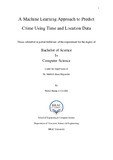| dc.contributor.advisor | Majumdar, Dr. Mahbub Alam | |
| dc.contributor.author | Shama, Nishat | |
| dc.date.accessioned | 2017-05-29T05:37:27Z | |
| dc.date.available | 2017-05-29T05:37:27Z | |
| dc.date.copyright | 2017 | |
| dc.date.issued | 4/18/2017 | |
| dc.identifier.other | ID 15141009 | |
| dc.identifier.uri | http://hdl.handle.net/10361/8197 | |
| dc.description | Cataloged from PDF version of thesis report. | |
| dc.description | Includes bibliographical references (page 51-52). | |
| dc.description | This thesis report is submitted in partial fulfillment of the requirements for the degree of Bachelor of Science in Computer Science and Engineering, 2017. | en_US |
| dc.description.abstract | Recognizing the patterns of criminal activity of a place is paramount in order to prevent it. Law enforcement agencies can work effectively and respond faster if they have
better knowledge about crime patterns in different geological points of a city.The aim of this paper is to use machine learning techniques to classify a criminal incident by type,depending on its occurrence at a given time and location.The experimentation is conducted on a data set containing San Francisco’scrimerecordsfrom2003-2015.For this supervised classification problem, Decision Tree, Gaussian Naive Bayes, k-NN, Logistic Regression, Ada boost, Random Forest classification models were used. As crime categories in the data set are imbalanced, oversampling methods, such as SMOTE and under sampling methods such as Edited NN, Neighborhood Cleaning Rule were used. Solving the imbalanced class problem, the machine learning agent was able to categorize crimes with approximately 81% accuracy. | en_US |
| dc.description.statementofresponsibility | Nishat Shama | |
| dc.format.extent | 52 pages | |
| dc.language.iso | en | en_US |
| dc.publisher | BRAC University | en_US |
| dc.rights | BRAC University thesis are protected by copyright. They may be viewed from this source for any purpose, but reproduction or distribution in any format is prohibited without written permission. | |
| dc.subject | Machine learning | en_US |
| dc.subject | Crime | en_US |
| dc.subject | Time and location | en_US |
| dc.title | A machine learning approach to predict crime using time and location data | en_US |
| dc.type | Thesis | en_US |
| dc.contributor.department | Department of Computer Science and Engineering, BRAC University | |
| dc.description.degree | B. Computer Science and Engineering | |

